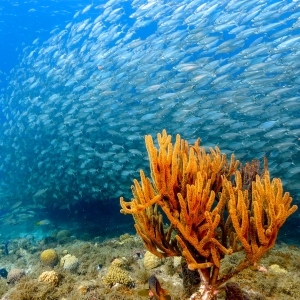The project of the graduate from Samara University Ariana Arguello from Costa Rica should assist countries of Central America in their fight against dangerous “red tides” that annually threaten human health and destroy marine flora and fauna. The presentation of the project, which is part of Ariana Arguello’s thesis, was included in the program of the International Astronautics Congress held in September. This was reported by the media of Costa Rica, including La República, one of the largest newspapers in the country.
“At Samara University in Russia, Ariana Arguello worked for more than a year on the project of monitoring “red tides” along the Pacific coast of not only Costa Rica, but also the whole of Central America. This project became part of Ariana’s thesis, and its presentation was included in the program of the International Astronautics Congress”, reported the newspaper La República.
So-called “red tides”, when the water in coastal areas turns red, arise because of the mass reproduction of microalgae. This often leads to the death of fish, turtles, crabs, shrimps, and other marine life. Due to the algae, the oxygen concentration in the water sharply reduces; moreover, a number of the algae emit toxins acting as nerve agents. In humans and pets, poisonous “red tides” can cause symptoms of poisoning, burning in the eyes, and skin irritation not only when swimming, but even when inhaling air from the sea, and eating poisoned fish or shellfish can cause paralysis or even death.
Ariana Arguello graduated from the Institute of Aviation and Rocket-Space Technology of Samara University this year. She completed her project as a graduate qualification work under the guidance of Denis Avaryaskin, Associate Professor of the Interuniversity Department of Space Research. The project involves using CubSat nanosatellites for remote sensing of the ocean surface from spaceto detect and monitor the spread of “red tides” that potentially threaten coastal areas of Central America. Applying special equipment from space orbit, it is possible to detect signs of the beginning of a certain type of algae bloom in advance, in order to take necessary preventive measures: for example, closing beaches, warning local residents, stopping fishing, and catching other seafood.
“The objective of my research was applying Earth remote sensing technology for solving problems of detecting and monitoring environmental disaster of a special kind to reduce its destructive impact on environment and economy”, the newspaper quotes Ariana Arguello’s words.
According to Ariana, due to her successful studies at Samara University, she will now be able to continue research in the field of Earth remote sensing for solving global environmental problems at one of the universities in Europe.
For reference
*Samara University has world-class competencies in the field of creating nanosatellites and developing Earth remote sensing equipment. For many years, the university has been hosting the International Summer Space School, in which students from various countries learn to design nanosatellites. Researchers from Samara University and the Institute of Image Processing Systems (ISOI) of the Russian Academy of Science (RAS) have developed the first domestic hyper-spectrometer for CubeSat nanosatellites. The device can implement environmental monitoring, monitor forests and agricultural crops, as well as perform other tasks.
